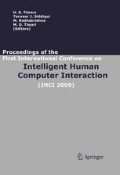Abstract
Proteins are highly complex and flexible structures. Rendering tools are often used to study their dynamics, functions and in some cases even deformations that arise due to slow dynamics. In this work, we present Pro Vis, a visualization tool for 3-dimensional rend ering of protein molecules with the ability to create and display anaglyph images. The tool allows for viewing the protein molecules, locating atoms, viewing bonds, viewing the protein backbone, searching for specific bonds, visualizing them and also analyzing the various scalar properties of the protein. The use of display lists allows for very fast rendering and real time animation of the complex molecules with negligible latency time between scenes. The novelty of the tool is the interface which combines the power of 3D visualization using anaglyphs with the geometry and graphics of the protein to provide a real-time interaction environment for large amounts of abstract data.
This work was done as part of summer internship at the Department of Computer Science and Automation, Indian Institute of Sciences, Bangalore
Preview
Unable to display preview. Download preview PDF.
References
Berman, H., Westbrook, J., Feng Z., Bhat G., Weissig H., Shindyalov N., Bourne P. E.: The Protein Data Bank. Nucleic Acids Research 28, 1, 235–242, (2000)
Humphrey W., Dalke A., Schulten K.: VMD — Visual Molecular Dynamics. In Journal of Molecular Graphics 14, pp. 33–38, (1996)
Delano L.: PyMOL. In DeLano Scientific LCC (1998–2004)
Kraulis J.: MOLSCRIPT — A Program to Produce Both Detailed and Schematic Plots of Protein Structure. In Journal of Applied Crystallography 24, pp 946–950, (1991)
OpenBabel: The Open Source Chemistry Toolbox, http://openbabel.org/
BALL View: Molecular Visualization Application, http://www.ballview.org/
PMV: Python Molecular Viewer, http://mgltools.scripps.edu/
Avogadro: Advanced Molecular Editor, http://avogadro.openmolecules.net/
Kalzium: Visualization Software, http://edu.kde.org/kalzium/
Sayle A., Milner-White J.: RASMOL: Biomolecular Graphics for All. In: Biochem. Science 20, 374–376, 1995
RasTop: Molecular Visualization Software, http://www.geneinfinity.org/rastop/
Protein Explorer: Protein Visualization Software, http://www.proteinexplorer.org/
Bohne-Lang A., Groch W., Ranzinger R.: AISMIG-An Interactive Server-side Molecule Image Generator. In Journal of Nucleic Acid Research, Vol 33 (Web Server issue) (2005)
Molecule Spatioplotter-3D Molecule Viewer, http://www.iktsoft.com/proj/chemistory/molecule.php
Santorini: Molecular Viewer, http://development.oeffner.net/
Wavefront. obj file format specification for the Advanced Visualizer software, http://local.wasp.uwa.edu.au/~pbourke/dataformats/obj/
Lampe O., Viola I., Reuter N., Hauser H.: Two-level Approach to efficient Visualization Of Protein Dynamics. In IEEE transactions on Visualization and Computer Graphics, 13 (6), 1616–1623 (2007)
The Open GL API for graphics, http://www.opengl.org/
The Qt application development framework, http://trolltech.com/products/qt/
Schneiderman B., Plaisant C.: Designing the User Interface: Strategies for
Effective Human-Computer Interaction. Addison-Wesley Publishing Company (1987)
Author information
Authors and Affiliations
Editor information
Editors and Affiliations
Rights and permissions
Copyright information
© 2009 Indian Institute of Information Technology, India
About this paper
Cite this paper
Bhasin, R., Kumar, A. (2009). ProVis: An Anaglyph based Visualization Tool for Protein Molecules. In: Tiwary, U.S., Siddiqui, T.J., Radhakrishna, M., Tiwari, M.D. (eds) Proceedings of the First International Conference on Intelligent Human Computer Interaction. Springer, New Delhi. https://doi.org/10.1007/978-81-8489-203-1_13
Download citation
DOI: https://doi.org/10.1007/978-81-8489-203-1_13
Publisher Name: Springer, New Delhi
Print ISBN: 978-81-8489-404-2
Online ISBN: 978-81-8489-203-1
eBook Packages: Computer ScienceComputer Science (R0)

